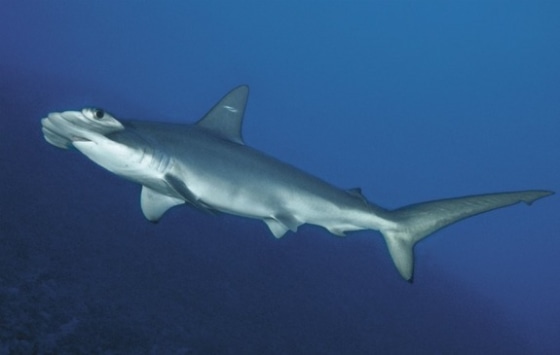New Hammerhead Shark Species Discovered
Posted by: Ken Gerhard on November 8th, 2013
We’re gonna need a bigger boat! A recent shark discovery… and it’s not a small animal.

Save Our Seas Foundation / Peter Verhoog
A scalloped hammerhead shark, which looks virtually identical to the newfound species, the Carolina hammerhead.
When new species are found near populated areas, they are often small and inconspicuous, not, for example, a hammerhead shark.
But that’s exactly what a team of researchers discovered along the coast of South Carolina. The new species looks virtually identical to the scalloped hammerhead, but is genetically distinct, and contains about 10 fewer vertebrae, or segments of backbone, new research shows.
The new species, named the Carolina hammerhead (Sphyrna gilbert), gives birth to shark “pups” in estuaries near the shore off the Carolinas, according to a study published in August in the journal Zootaxa.
To find the shark, scientists led by University of South Carolina fish expert Joe Quattro collected 80 young sharks that looked liked scalloped hammerheads. They then analyzed their DNA, and found that they were distinct from their scalloped cousins. Further analysis found more subtle differences; the new species is slightly smaller, for instance, according to the study. Of these 80 sharks, 54 of them belonged to the new species, the study noted.
Read the rest of the article here.
About Ken Gerhard
Ken has investigated reports of mysterious beasts around the world including Bigfoot, the Loch Ness Monster, the Chupacabra, giant winged creatures and even werewolves. In addition to appearing in three episodes of the television series Monster Quest (History Channel), Ken is featured in the History Channel special The Real Wolfman, as well as Legend Hunters (Travel Channel/A&E), Paranatural (National Geographic), Ultimate Encounters (truTV) and William Shatner's Weird or What? (History Television). His credits include multiple appearances on Coast to Coast AM, major news broadcasts and Ireland’s Newstalk radio, as well as being featured in major books and in articles by the Associated Press, Houston Chronicle and Tampa Tribune. Ken is author of the books Big Bird: Modern Sightings of Flying Monsters and A Menagerie of Mysterious Beasts: Encounters with Cryptid Creatures, as well as the co-author of Monsters of Texas (with Nick Redfern) and has contributed to trade publications including Fate Magazine, Animals and Men, The Journal of the British Columbia Scientific Cryptozoology Club and Bigfoot Times. He currently lectures and exhibits at events across America. Born on Friday the 13th of October, 1967 (exactly one week before the famous Patterson Bigfoot film was shot), Ken has traveled to twenty-six different countries on six continents and most of the United States. An avid adventurer, he has camped along the Amazon, explored the Galapagos, hiked the Australian Outback and has visited many ancient and mysterious sites, from Machu Pichu to Stonehenge.










Hammerheads. Why aren’t the called “Wingheads” instead? Getting the eyes out on the ends of those wings – pretty brilliant. I suppose; is this really an advantage? Sharks aren’t really so much visual creatures, right? So… just an experimental program that never got shut down for lack or positive results?
Having the eyes out on the sides like that gives the shark 360-degree vision; the shape of the head also spreads out its electroreceptor sensory organs over a wider area. So, pretty good adaptations. Hammerheads actually can also use their heads to hold down stingrays so they can more easily take a bite. Also of note, one species of hammerhead actually is called the Winghead Shark.
Here’s to swimmin’ with bow legged wimmin’.
But there are some severe “blind spots” in the 360-degree vision, are there not – the biggest being the shark’s own body?
Notice that they made the discovery of a new shark species by examining the DNA after they collected the sample carcasses…and not before. The work of real scientists practicing real science – how refreshing.
cryptokellie:
Well, see, this is the thing I don’t get. Nobody doing science on accepted animals is OK with somebody going “you have to believe me, this is a new species, here, look at this slide”?
So howcomesit that this is suddenly OK when somebody tosses a scientist some hairs that, hey, they say the hairs might be yeti? Even though they didn’t actually take them off the body of an animal? And when the scientist finds out they’re an accepted animal, suddenly yeti has to be that animal, and it’s mystery solved?
Big head-scratcher, that one.
Excellent point DWA. To actually prove an animal as Bigfoot exists, you have to actually find one. Not test some sample from somewhere and when it turns out to be from something else, claim that’s what a Bigfoot is. It’s called pretzel logic, I think. A song comes to mind…
“I could while away the hours-conferring with the flowers,
consulting with the rain. (whistling)
And my head I’d be scratchin’ while my thoughts were busy hatchin’ – if I only had a…”